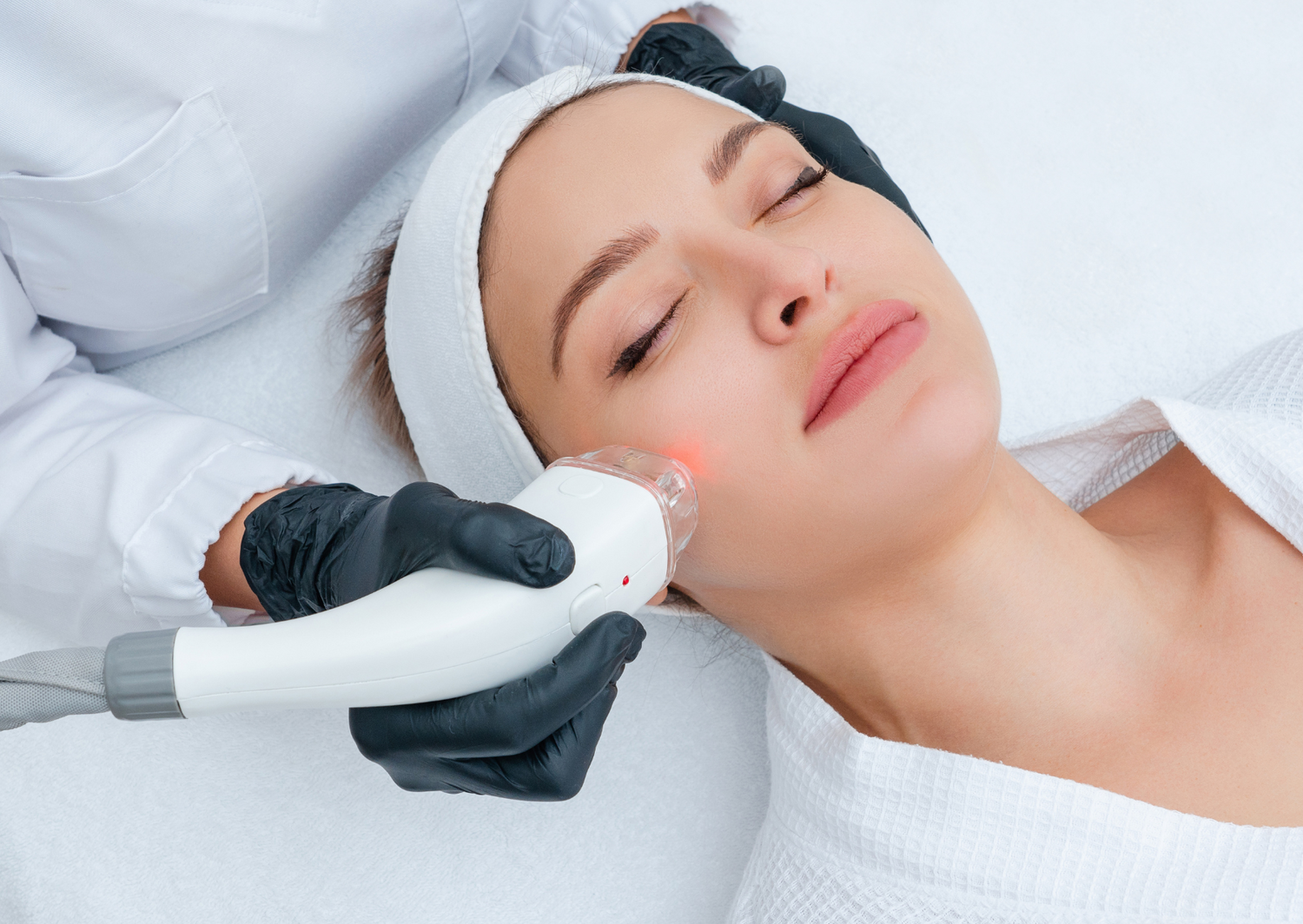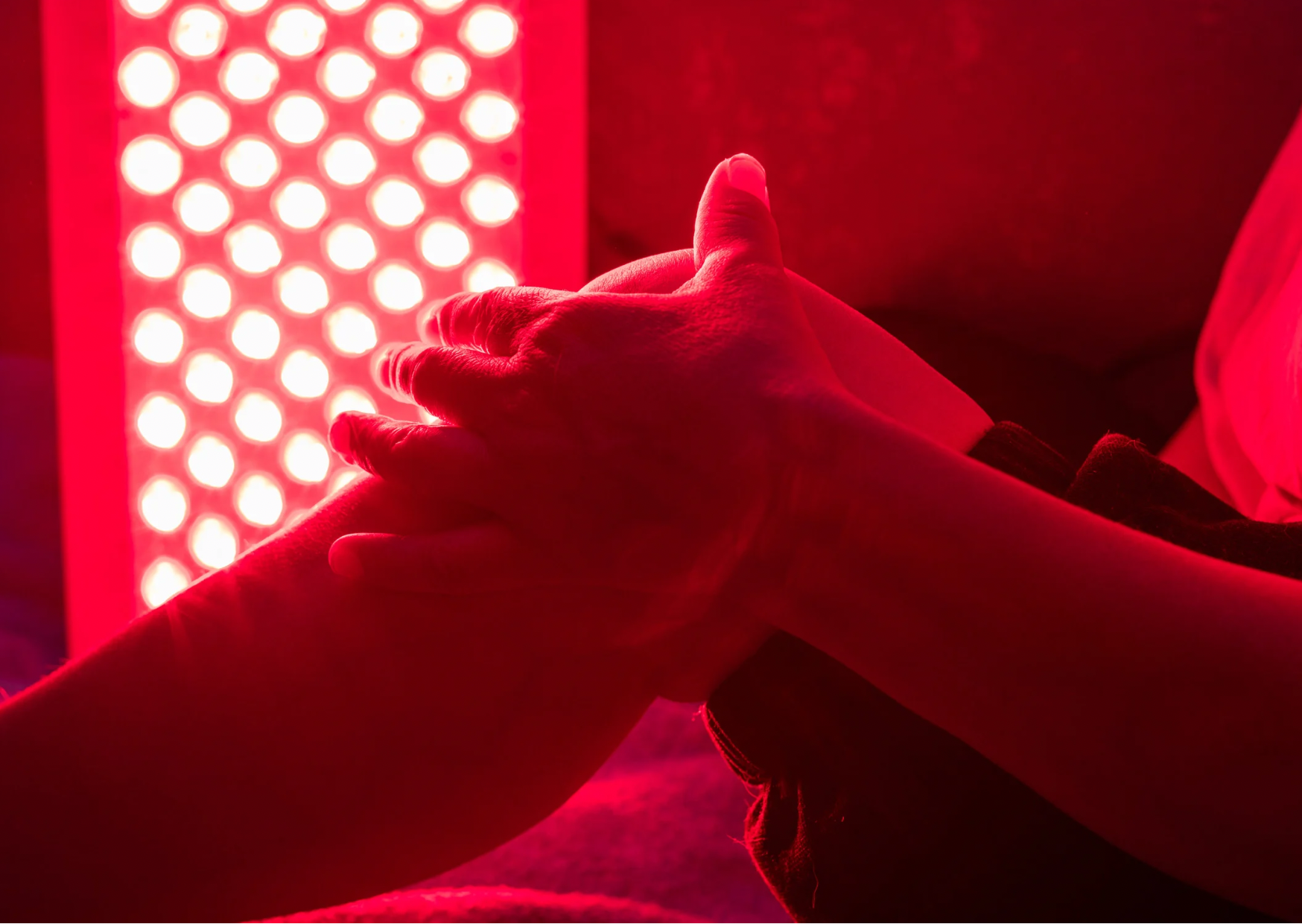Low-level laser therapy, LED light therapy, low-level light therapy, red light therapy, photobiomodulation… aghhh! What is what?
We’ve cleared it up.
What falls under "Red Light Therapy"?
Low-level laser therapy (laser) and LED red light therapy (LUMEBOX) can both be described by the umbrella term “red light therapy”. If you read the scientific papers, you might also see these therapies referred to as "low-level light therapy" or "photobiomodulation”. However, they differ in important ways.

The origin story of Red Light Therapy
Red light therapy was originally discovered during research in the 1960s that aimed to use high-energy laser devices to destroy cancer cells.
While some studies focused on using high-energy lasers for different purposes, researchers experimenting with low-energy lasers discovered that they unexpectedly promoted hair growth and wound healing in rats [1].
This discovery led to the development of low-level laser therapy (LLLT).
Laser devices were considered preferable for therapeutic treatments until the early 2000s when studies progressed to testing the effects of LLLT on humans, and gradually, scientists and sports therapists started noticing how powerful of a tool LED light therapy was for addressing pain, joint, and soft tissue injuries.
Over the past few decades, LED technology has surged in popularity—not only for treating joints and muscles but increasingly for skin health too. While most of the published science is on laser technology (approximately 85-90%, practically all red light therapy research before the 21st century), more and more papers using LED light therapy are being released every year.
So what is Red Light Therapy?
A non-invasive wellness tool that uses specific wavelengths of red (RED) and near-infrared (NIR) light, delivered at high enough power, to penetrate the skin and encourage the cells to work better.
How does it work?
Tiny receptors in our cells are responsive to red and near-infrared light. When stimulated, they prompt the mitochondria to work harder. The mitochondria are the powerhouses of our cells, producing energy for all the processes in our body, so when they’re working efficiently, the downstream effects include healthier skin, temporary reduction in pain and inflammation, faster muscle recovery… you get the idea!
What is Laser Light Therapy?
"Laser" stands for Light Amplification by Stimulated Emission of Radiation.
It's a highly focused and powerful type of light that travels in a straight line, unlike regular light that spreads out. Lasers use a process called stimulated emission, where excited atoms (atoms with extra energy) release energy as light. This light is all one color and perfectly aligned, making lasers ideal for precision tasks like surgery, cutting, and red light therapy.
Most people know Red Light Therapy for its skin benefits - but why?
Red light therapy is known to support collagen [7], healthy inflammation, and cellular repair [8]—all of which are beneficial for improving skin tone and reducing the appearance of wrinkles.
Laser therapy is a popular in-clinic skin treatment, using various focused light treatments to address skin concerns like acne, wrinkles, scars, and pigmentation.
For example, CO2 lasers, are applied for deep skin resurfacing, while fractional laser treatment targets both surface and deeper layers for comprehensive rejuvenation. Intense pulsed light treatments offer less invasive options with slightly less downtime than others.
There are more laser treatments out there too - the clinic will usually help you decide which is best for you.
What else is Laser Light Therapy used for?
Since laser uses such a concentrated beam (read our blog to see why beam angle and scatter make red light bulbs ineffective for light therapy), lasers are also used for precise medical treatments to target wounds, small sections of bone, tendons, and for hair growth or hair removal. With enough power, they can even be used for cutting!
The downsides of Laser Therapy
Laser therapy has its benefits, but be prepared for the following:
- Involves a risk of side effects like redness and swelling, and requires longer downtime for recovery, especially after deeper treatments like CO2 laser. With skin resurfacing, there’s also a risk of pigmentation because the newly exposed skin is more vulnerable.
- The procedure can be warm and somewhat painful
- Laser treatments are typically very expensive ($200 - $3,000!) due to the advanced technology involved and the need for in-clinic administration by trained professionals.
So how is this different from LUMEBOX?
It's true that the light from LUMEBOX is also referred to as red light therapy, but the key difference is that LUMEBOX delivers this light using LEDs rather than lasers.
People assume that laser and LED light therapy offer similar benefits, but in practicality, they are used quite differently.
It’s possible to pay for an LED light therapy treatment as a part of a facial (usually for about $300), but the majority of LED devices are built for at-home use (such as LUMEBOX, which you can get here for $369 - subscribe to our email list for details!).
LEDs provide light at a much lower cost per mW of power compared to laser devices!
LED light therapy is gentler, with minimal side effects and no downtime, making it a more convenient and accessible option for many users. Additionally, LED devices like LUMEBOX have a wider beam angle compared to lasers, allowing them to cover larger areas of the body, such as the back or face.
A few of LED’s amazing benefits include:
- Skin Rejuvenation - Supporting the appearance of fine lines, pimples, and breakouts.
- Muscle Recovery - supporting repair and relaxation of muscles after exercise, and reducing soreness.
- Joint Health - by supporting healthy inflammation and tissue repair.
- Supporting Rest
What’s best for you?
After dramatic, faster results? Laser might be the option for you.
For most of our daily health concerns, laser devices are almost too precise if you’re not after highly targeted treatments or specialized medical applications.
Many studies show that laser and LED are equally effective for a whole range of cases, from TMJ [2] to knee osteoarthritis [3], and healing [4], and in some cases, LED performed better than laser [5,6].
LED red light therapy is a great option if you’re looking to maximize long-term health from the comfort of your own home. LUMEBOX is a portable device designed by a doctor with your health in mind! It’s 3rd party tested for irradiance, wavelength, and safety, is FDA registered, and has a long battery life so you can take it on your travels!
Time to get your glow on!
New to red light therapy? Download our free eBook to help you choose the best device.
Already have a LUMEBOX? Download our 6 time-saving tricks guide!
Medical Disclaimer: The information contained in this blog post is intended for educational purposes only and should not be used as medical advice. Everyone responds to light differently. Testimonials are not a guarantee of the results you or anyone who uses LUMEBOX will get because your success depends entirely on your circumstances, and the studies on red light therapy shared were not specifically performed using LUMEBOX. Please check with your doctor before using red light therapy and do not change your medical treatments or lifestyle without consulting your physician first.
References:
[1] Mester, E., Spiry, T., Szende, B., & Tota, J. G. (1971). Effect of laser rays on wound healing. The American Journal of Surgery, 122(4), 532-535. https://doi.org/10.1016/0002-9610(71)90482-X
[2] Panhoca VH, Lizarelli Rde F, Nunez SC, Pizzo RC, Grecco C, Paolillo FR, Bagnato VS. Comparative clinical study of light analgesic effect on temporomandibular disorder (TMD) using red and infrared led therapy. Lasers Med Sci. 2015 Feb;30(2):815-22. doi: 10.1007/s10103-013-1444-9. Epub 2013 Oct 3. PMID: 24197518.
[3] Ammar TA. Monochromatic Infrared Photo Energy versus Low Level Laser Therapy in Patients with Knee Osteoarthritis. J Lasers Med Sci. 2014 Fall;5(4):176-82. PMID: 25653818; PMCID: PMC4281991.
[4] Lima AC, Fernandes GA, de Barros Araújo R, Gonzaga IC, de Oliveira RA, Nicolau RA. Photobiomodulation (Laser and LED) on Sternotomy Healing in Hyperglycemic and Normoglycemic Patients Who Underwent Coronary Bypass Surgery with Internal Mammary Artery Grafts: A Randomized, Double-Blind Study with Follow-Up. Photomed Laser Surg. 2017 Jan;35(1):24-31. doi: 10.1089/pho.2016.4143. Epub 2016 Aug 25. PMID: 27564925.
[5] Esper MA, Nicolau RA, Arisawa EA. The effect of two phototherapy protocols on pain control in orthodontic procedure--a preliminary clinical study. Lasers Med Sci. 2011 Sep;26(5):657-63. doi: 10.1007/s10103-011-0938-6. Epub 2011 May 31. PMID: 21626017.
[6] Freitas AC, Campos L, Brandão TB, Cristófaro M, Eduardo Fde P, Luiz AC, Marques MM, Eduardo Cde P, Simões A. Chemotherapy-induced oral mucositis: effect of LED and laser phototherapy treatment protocols. Photomed Laser Surg. 2014 Feb;32(2):81-7. doi: 10.1089/pho.2013.3576. Epub 2014 Jan 29. PMID: 24476495.
[7] Lee YS , Park K, Choi J, et al. A prospective, randomized, placebo-controlled, double-blinded, and split-face clinical study on LED phototherapy for skin rejuvenation: clinical, profilometric, histologic, ultrastructural, and biochemical evaluations and comparison of three different. J Photochem Photobiol.2007;88:51-67.
[8] Hamblin MR. Mechanisms and applications of the anti-inflammatory effects of photobiomodulation. AIMS Biophys. 2017;4(3):337-361. doi: 10.3934/biophy.2017.3.337. Epub 2017 May 19. PMID: 28748217; PMCID: PMC5523874.





